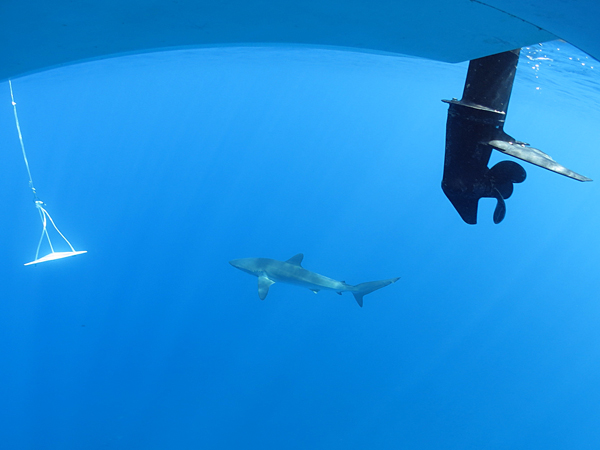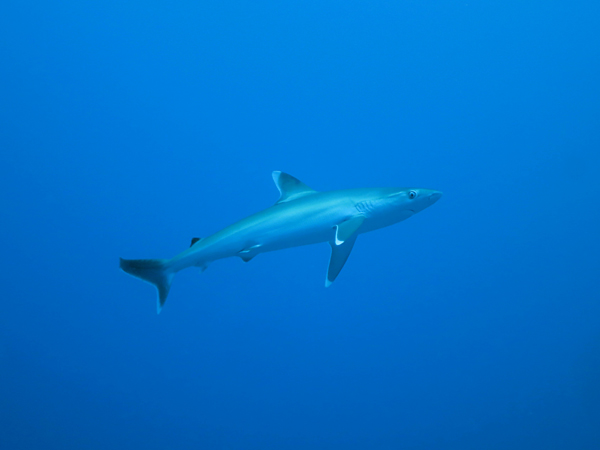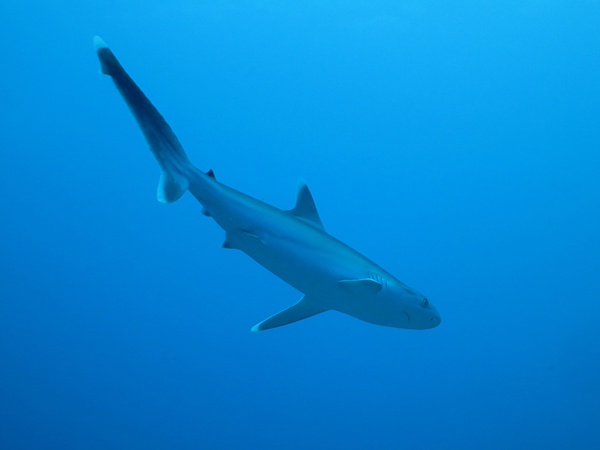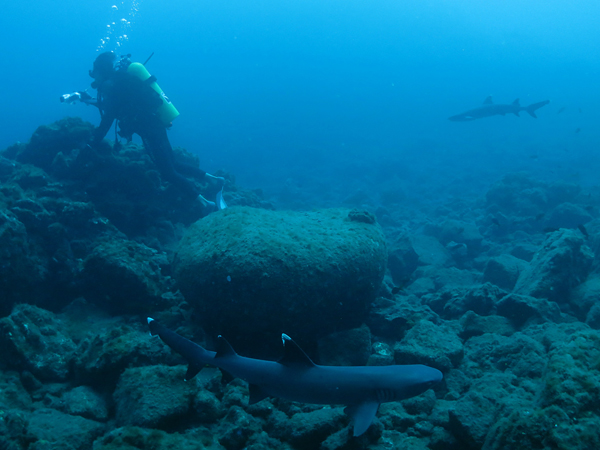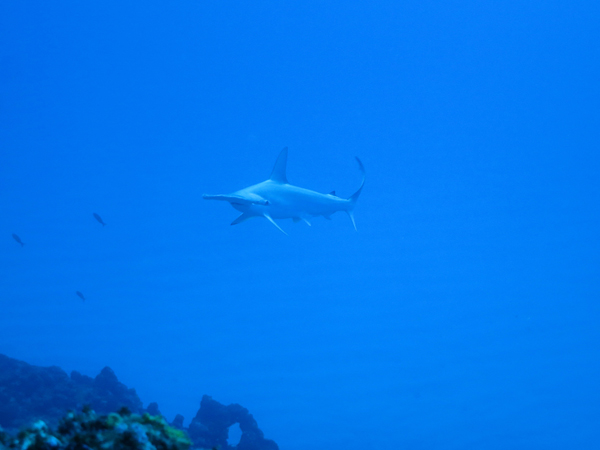Apparently every boat that visits the Revillagigedo Islands gets their very own shark entourage. Really, it’s uncanny and, I’m not going to lie, it’s a little unsettling. Within an hour of setting our anchor off Isla San Benedicto we peered into the crystal blue beneath Orion to see the smooth swaggers of long pointed tails. During all seven days in this location 3-4 sharks circled slowly in our dark shadow. We were expecting (and hoping) to see sharks on this expedition, but their instantaneous interest in us made me think twice about swimming off the boat. While we refrained from cannonballs into this shark soup we did don our masks and peer into the watery depths to check out the neighborhood. Turns out our stealthy stalkers were 4-6 foot silky sharks, placid as can be. Eventually we got used to them and felt comfortable enough to join them in the water for a spell.
When we moved over to Isla Socorro it was the same game with different players. Here silver tip sharks patrolled the water beneath Orion. These guys were small (3-4 feet) but assertive. When we dove under the boat to retrieve a dropped weight belt they took turns charging straight toward us and then abruptly turning when they came within 10-15 feet. They were like little schoolyard punks trying to psyche us out. If we looked away they would get a lot closer, but immediately turn as our gaze met theirs. All of the silver tips that we saw were like this- small with aggressive behavior- which we loved, because it shows gusto and makes for great photos. But I might feel differently about their older relatives (that grow to nine feet long) doing the same.
This was my first time diving around so many sharks and I have to say it is an awesome experience. We saw white tips on every dive, had daily encounters with silver tips and silkies, had run-ins with scalloped hammerheads, and glimpsed two large tiger sharks (one was uncomfortably large). To witness the power and the grace of these large creatures is humbling. It also makes for some healthy planetary perspective to not be at the tippy-top of the food web for a little while. These encounters were incredible, but could also be intimidating. We kept strict guidelines when diving to combat our nerves. We constantly looked all around, stuck close to each other, and minimized time in open water and at the surface. We even dove with aluminum poking sticks that could be used if one buzzed a little too close. We had been told to keep a lookout because making eye contact with a shark will often cause it to stop approaching. We found both eye contact and our loud bubbles keep sharks away. It was a fine balance of breath holding and gazing peripherally to get them to swim in for a closer look.
Even though we were completely wowed by the number of sharks we saw, shark abundance was remarkably low this winter at the islands. Thanks to El Niño, the winter water temperature was a balmy 75 degrees F rather than the more common 70 degrees. Because of this, the species composition was a bit skewed, and according to the dive boats there were far fewer sharks (and whales) than normal. While it is customary to see large schools of hammerheads in some of the deeper canyons there were only a few to be found. Instead they all seem to have gone north this winter, as large schools of hammerheads were surprisingly seen seen off San Diego, CA.
Speaking of shark soup, I can’t discuss sharks without mentioning that they are in danger of being wiped off the map. Around the world sharks are being fished at a faster rate than they can recover from. It is predicted that if the killing continues many species will be lost with serious effects on marine ecosystems. Sharks are targeted for their meat and many are caught as bycatch in other fisheries, but the majority are fished for their fins, used in shark fin soup, a delicacy in Asian cuisine. There is big money in this trade (up to $650 USD per kilogram), so much that it outweighs the long-term incentives to fish sustainably and the repercussions of fishing illegally. Sharks have relatively slow growth rates, late sexual maturity, and low numbers of young per brood making them more susceptible to overfishing. There is also a lack of worldwide shark catch data, however sharks killed for fins alone are estimated at 26 to 73 million annually.
As top predators many sharks play a more critical role in marine ecosystems than the average fish. As odd as it may sound more sharks equal a more balanced ecosystem. They eat older, weak or sick individuals, keeping prey populations healthy and resilient. Through predation, they keep many species from overpopulating and outcompeting for resources. Even though the shark fin trade brings in huge amounts of money studies have shown that live sharks are worth far more than dead. There are documented cases of population crashes in important commercial species due to the decline of sharks including scallops in North Carolina and oysters in Chesapeake Bay. Through the ecotourism industry live animals bring in money to communities continually over time rather than one sum to a few individuals for a dead animal.
We can all do our part to help turn the tide for sharks worldwide. Shark fin bans have gone into effect in Guam, Saipan and in the US states: HI, CA, OR, TX, IL, NY, MA, DE, and MD. These are landmark pieces of legislation that have done much to not only curb trade but also spread awareness. However, the shark fin trade is a tough subject with multiple perspectives.This food is an important cultural tradition for many people. Like any type of seafood the focus needs to be on coming up with metrics and mechanisms for sustainable harvesting techniques and quotas. However this is difficult to do as a planet, with so many differing values, needs, and an immense geographic area to monitor. At this point shark fins are not harvested sustainably yet are bought and sold with vigor, therefore education seems best way to turn the tide. Reducing demand for sharks would go far to reducing the economic incentive for fishing them. It is amazing how access to information and varied global perspectives can change traditions and cultural rules in as little as one generation. I honestly believe that those who value sharks in any way do not want to see them disappear. It is important that when conservation initiatives are passed we help enforce them by following the rules and loudly declining to support individuals and businesses that break them. We need make informed decisions about what we kill and we eat. There are many sustainably harvested and less impacted seafood options to choose from and sharks need a break (to learn more about choosing seafood wisely visit Seafood Watch and Marine Stewardship Council).
It is a gift to witness a scene filled with these powerful creatures. It is my hope that globally we can shift to sustainable fishing practices so that scenes like this can be witnessed by future generations, and “shark soup” can describe the waters within a healthy ecosystem, rather than a rare item on a menu.

